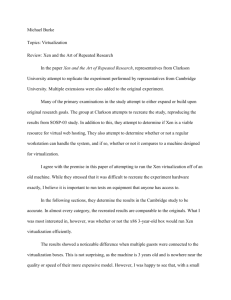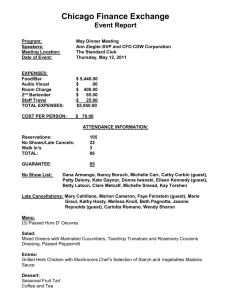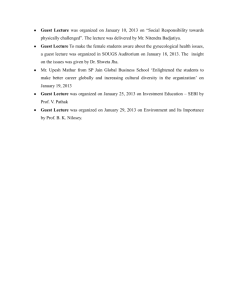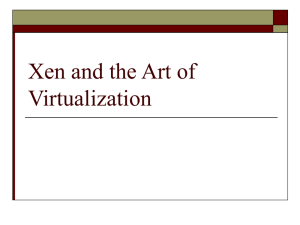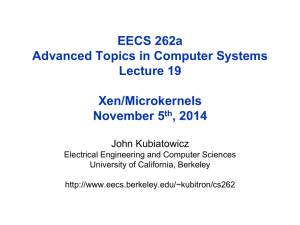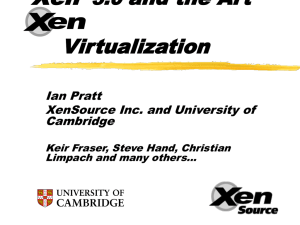Xen and The Art of Virtualization
advertisement
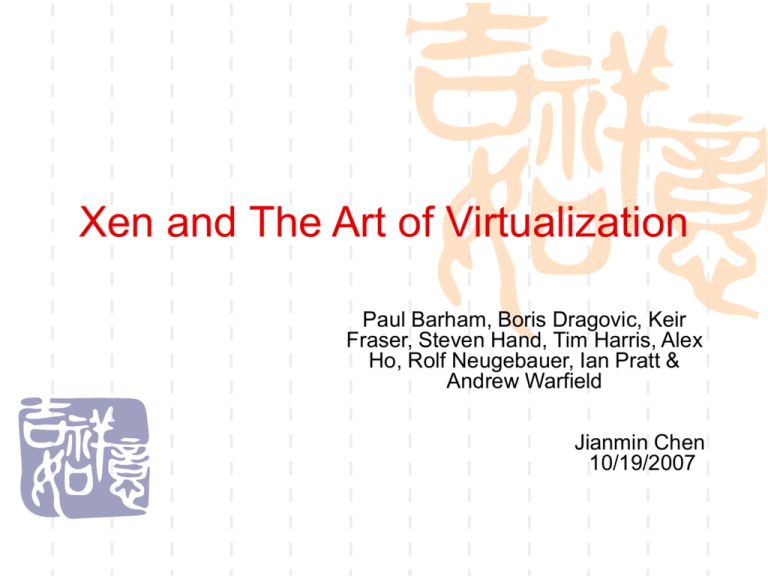
Xen and The Art of Virtualization Paul Barham, Boris Dragovic, Keir Fraser, Steven Hand, Tim Harris, Alex Ho, Rolf Neugebauer, Ian Pratt & Andrew Warfield Jianmin Chen 10/19/2007 Motivation up to 100 virtual machine instances Simultaneously on a modern server. Concerns Variety: Allow for full-blown operating systems of different types Commodity hardware & O/Ss, but requires some source code modifications Isolation: Guest OS should not affect each other Efficiency: Reduce overhead Enhanced OS? It is possible to re-design O/Ss to enforce performance isolation E.g. resource containers [OSDI’99] Difficult to account for all resource usage to a process For instance, buffer cache is shared across processes – a process may have a larger share of it than others Page replacement algorithms generate process interference – “crosstalk” Classic VM: Full Virtualization Functionally identical to the underlying machine Allow unmodified operating systems to be hosted Difficult to handle sensitive but not privileged instructions Not efficient to trap everything (Syscall …) Sometimes OS wants both real and virtual resource information: Timer Xen Design principles: Unmodified applications: essential Full-blown multi-task O/Ss: essential Paravirtualization: necessary for performance and isolation Xen Xen VM interface: Memory Memory management Guest cannot install highest privilege level segment descriptors; top end of linear address space is not accessible Guest has direct (not trapped) read access to hardware page tables; writes are trapped and handled by the VMM Physical memory presented to guest is not necessarily contiguous Details: Memory 1 TLB: challenging Software TLB can be virtualized without flushing TLB entries between VM switches Hardware TLBs tagged with address space identifiers can also be leveraged to avoid flushing TLB between switches x86 is hardware-managed and has no tags… Decisions: Guest O/Ss allocate and manage their own hardware page tables with minimal involvement of Xen for better safety and isolation Xen VMM exists in a 64MB section at the top of a VM’s address space that is not accessible from the guest Details: Memory 2 Guest O/S has direct read access to hardware page tables, but updates are validated by the VMM Through “hypercalls” into Xen Also for segment descriptor tables VMM must ensure access to the Xen 64MB section not allowed Guest O/S may “batch” update requests to amortize cost of entering hypervisor Xen VM interface: CPU CPU Guest runs at lower privilege than VMM Exception handlers must be registered with VMM Fast system call handler can be serviced without trapping to VMM Hardware interrupts replaced by lightweight event notification system Timer interface: both real and virtual time Details: CPU 1 Protection: leverages availability of multiple “rings” Intermediate rings have not been used in practice since OS/2; x86-specific An O/S written to only use rings 0 and 3 can be ported; needs to modify kernel to run in ring 1 Details: CPU 2 Frequent exceptions: Software interrupts for system calls Page faults Allow “guest” to register a ‘fast’ exception handler for system calls that can be accessed directly by CPU in ring 1, without switching to ring-0/Xen Handler is validated before installing in hardware exception table: To make sure nothing executed in Ring 0 privilege. Doesn’t work for Page Fault Xen VM interface: I/O I/O Virtual devices exposed as asynchronous I/O rings to guests Event notification replaces interrupts Details: I/O 1 Xen does not emulate hardware devices Exposes device abstractions for simplicity and performance I/O data transferred to/from guest via Xen using shared-memory buffers Virtualized interrupts: light-weight event delivery mechanism from Xen-guest Update a bitmap in shared memory Optional call-back handlers registered by O/S Details: I/O 2 I/O Descriptor Ring: OS Porting Cost Number of lines of code modified or added compared with original x86 code base (excluding device drivers) Linux: 2995 (1.36%) Windows XP: 4620 (0.04%) Re-writing of privileged routines; Removing low-level system initialization code Control Transfer Guest synchronously call into VMM Explicit control transfer from guest O/S to monitor “hypercalls” VMM delivers notifications to guest O/S E.g. data from an I/O device ready Asynchronous event mechanism; guest O/S does not see hardware interrupts, only Xen notifications Event notification Pending events stored in per-domain bitmask E.g. incoming network packet received Updated by Xen before invoking guest O/S handler Xen-readable flag may be set by a domain To defer handling, based on time or number of pending requests Analogous to interrupt disabling Data Transfer: Descriptor Ring Descriptors are allocated by a domain (guest) and accessible from Xen Descriptors do not contain I/O data; instead, point to data buffers also allocated by domain (guest) Facilitate zero-copy transfers of I/O data into a domain Network Virtualization Each domain has 1+ network interfaces (VIFs) Each VIF has 2 I/O rings (send, receive) Each direction also has rules of the form (<pattern>,<action>) that are inserted by domain 0 (management) Xen models a virtual firewall+router (VFR) to which all domain VIFs connect Network Virtualization Packet transmission: Guest adds request to I/O ring Xen copies packet header, applies matching filter rules E.g. change header IP source address for NAT No change to payload; pages with payload must be pinned to physical memory until DMA to physical NIC for transmission is complete Round-robin packet scheduler Network Virtualization Packet reception: Xen applies pattern-matching rules to determine destination VIF Guest O/S required to exchange unused page frame for each packet received Xen exchanges packet buffer for page frame in VIF’s receive ring If no receive frame is available, the packet is dropped Avoids Xen-guest copies; requires pagealigned receive buffers to be queued at VIF’s receive ring Disk virtualization Domain0 has access to physical disks Currently: SCSI and IDE All other domains: virtual block device (VBD) Created & configured by management software at domain0 Accessed via I/O ring mechanism Possible reordering by Xen based on knowledge about disk layout Disk virtualization Xen maintains translation tables for each VBD Used to map requests for VBD (ID,offset) to corresponding physical device and sector address Zero-copy data transfers take place using DMA between memory pages pinned by requesting domain Scheduling: batches of requests in roundrobin fashion across domains Evaluation Microbenchmarks Stat, open, close, fork, exec, etc Xen shows overheads of up to 2x with respect to native Linux (context switch across 16 processes; mmap latency) VMware shows up to 20x overheads (context switch; mmap latencies) UML shows up to 200x overheads Fork, exec, mmap; better than VMware in context switches Thank you

